Radio direction finders of German U-boats in WWII
by Robert Derencin
Introduction
Every time when someone uses any communication device which transmit electromagnetic waves, it can be detected and its position can be fixed. In WW2 almost every surface ship or a submarine were equipped with radio stations. Because of that the Allies and the Axis forces established radio direction-finder services. The service's duty was to find position of enemies' radio stations. Intention of this article is to explain radio detection finders fitted on German submarines in WW2, tactics of their use and how the Allies ships could reduced efficacious of the radio direction finders.
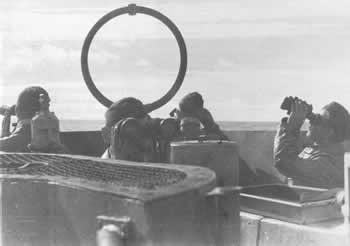
U-67 showing its antennae.
Technical description of DF
Radio direction finder is a system consisted of a receiver and an antenna. The antenna has to be specially designed for direction finders purpose. German submarines in WW2 were fitted with a loop type DF antenna. The antenna had to be able rotate on its axis. The rotation mainly was by hand, by means of a handle. Picture number 1 shows radio direction finder consisted of receiver (1), loudspeaker (2), loop antenna (3) and a handle (4).
Picture 1: Radio direction finder:
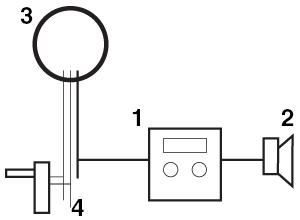
Picture number 2 shows external look of radio direction finder loop antenna.
Picture 2:
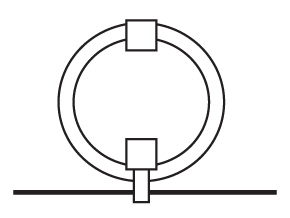
The loop antenna was designed for two maximum fields of reception and two minimum fields of reception. By rotation of the antenna on its axis operator was able to determine direction of the electromagnetic source i.e. radio-azimuth. The radio-azimuth is angle between true meridian and direction of reception of the electromagnetic (or radio) waves. Problem was because the loop antenna had two maximum fields of reception and because of that the operator could to make mistake of 180 degrees. Solution of that problem is explained in the next chapter. Picture number 3 shows layout (view from above) of a radio-direction finder loop antenna. Maximum fields of reception are marked by "+" and minimum fields of reception are marked by "-".
Picture 3: Layout of a loop antenna.
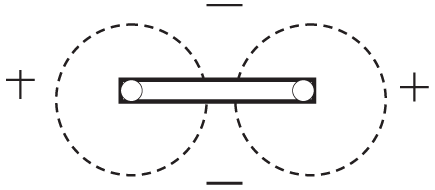
Direction finder tactics
As mentioned in chapter 2, radio-direction finders used on the Kriegsmarine U-boats were able to determine direction of the Allies ships, with possible error of 180 degrees. In this chapter two possibilities how that problem can be solved will be seen.
Picture 4:
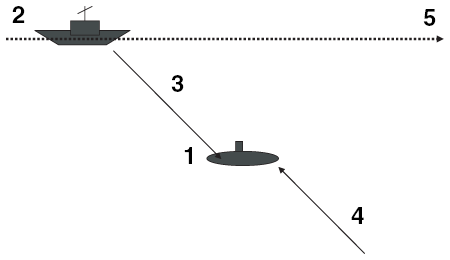
Picture number 4 shows situation when single submarine (1) receives radio signal from the Allied surface ship or a convoy (2). The submarine determines two possible radio-azimuths, 315 (3) and 135 degrees (4). But, because of previous experience, the submarine knows usual routes of the Allied convoys (5). The submarine knows that the true radio-azimuth is 315 degrees. The submarine transmits the radio-azimuth to another submarines and to her base (Headquarter). By continuous watching of the ship's or the convoy radio traffic, the submarine will know the ship's or the convoy speed.
Picture 5:
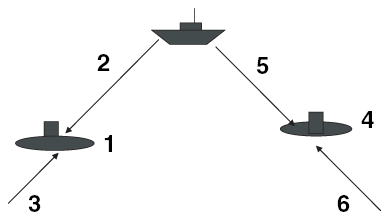
Picture number 5 shows situation when (at least) two submarines receive radio signal from the Allied surface ship or a convoy. Both submarines receive the same radio signal.
Also the both submarines determine two possible radio-azimuths. One submarine (1) has two possible azimuths, 45 (2) and 225 (3) degrees. Another submarine (4) also has two possible radio-azimuths, 315 (5) and 135 (6) degrees. But, after the submarines communicate with one another, or after the submarines communicate with their base (Headquarter), the submarines will find out real radio-azimuths, 45 and 315 degrees. In this case correct position of the ship or the convoy is known. How many radio direction finders (fitted on a surface ship, a submarine or a coastal DF), so much is more easy to determine position of the electromagnetic (radio signal) source.
Conclusion
There was a great progress of radio communications ( and electronics at all ) in the WW2. When ships got possibility to communicate by means of radio stations, it was impossible to expect that they gave up of that possibility. But, there was also great improvement of electronics counter measures in the WW2. Every side involved in the WW2 had their own services of radio direction finders ( also known as Huff-Duff, which mean High Frequency Direction Finder). Because of all that mentioned above, it was necessary that radio operators used their radio stations with high level of professionalism, technical knowledge and discipline. First, every ship before went on her way, got plan of radio communications. The plan was consisted of list of call signs, list of identification codes, list of codes used in messages and list of frequencies. It was essential that the radio operators made radio communications exactly by the plan. Second, every communication had to be short as much as possible, because if the message was short it was less possibility that the radio direction finders would determine position of radio station (i.e. position of a ship or a convoy). Third, there should be just necessary radio communications between a ship and a convoy with their bases and ports. Inside a convoy ships could communicate one to another by means of Aldis -lamp. All three rules mentioned above couldn't interrupt work of the radio direction finders but the work was more difficult and less precise.
Because of great growth of the Allies' merchant marine and because of big losses of merchant marine ships and their crews, period of training of new radio operators was more and more short. Because of that, the fresh radio operators made mistakes and their mistakes sometimes had a big cost.
This article explains working system of a radio direction finder fitted on German U-boats during the WW2. But, on the same way also worked coastal radio direction finders. On the same way Germans located illegal radio stations located on whole territory of (those days) occupied Europe, radio stations which worked in Great Britain etc.
Radio directing was (and now is) strong weapon in electronic warfare, but it isn't all-powerful. Some of ways how to eliminate radio directing are mentioned in this chapter.
This article was published on 5 Jan 2003.
|
Books dealing with this subject include
|

